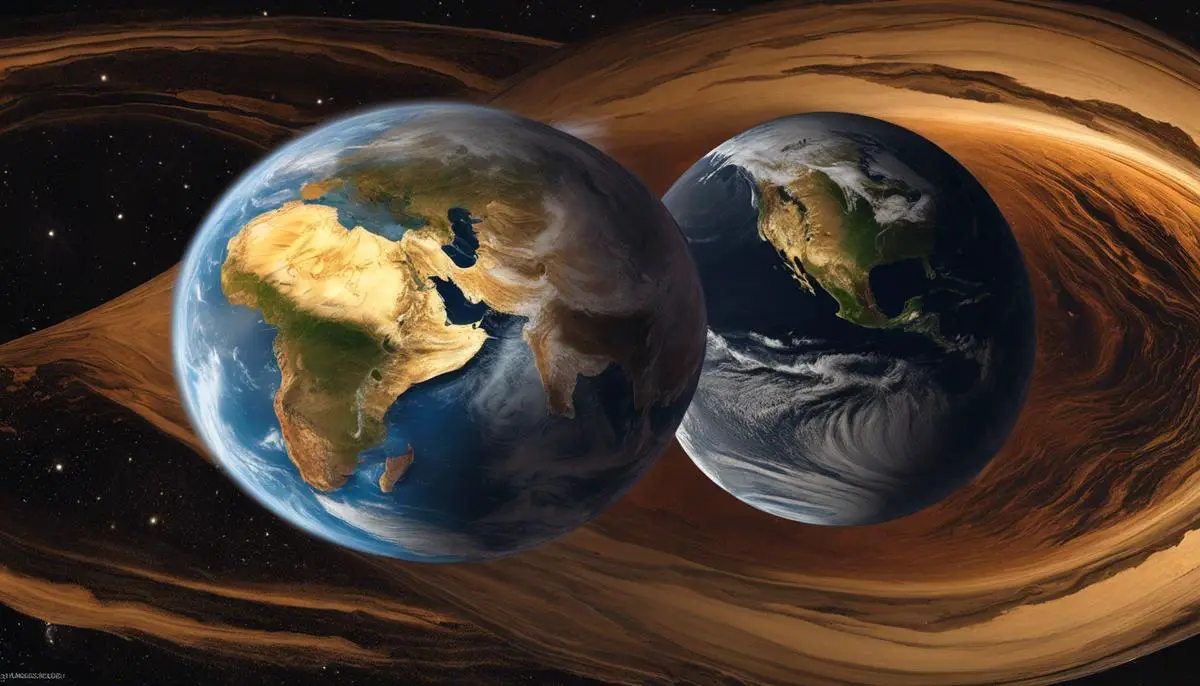Venus and Earth, celestial neighbors in our solar system, present a captivating study in contrasts and similarities, offering a rich tapestry of insights into the dynamics of planetary evolution. From the swirling shrouds of thick atmospheric gases on Venus to the life-sustaining air of Earth, these two worlds provide a stark comparison of atmospheric composition and dynamics. The turbulent dance of Venus’s super-rotating atmosphere sets a dramatic backdrop against the more familiar rhythm of Earth’s weather patterns. Moving beyond the skies, a closer look at their geological features reveals a narrative of volcanic activity, mountain formation, and the profoundly different ways each planet has sculpted its face through the aeons. Beyond the rocks and gas, the question of life’s potential whispers in the shadows, compelling us to examine the extreme conditions of Venus in a new light. As our quest for knowledge propels us forward, this essay embarks on an exploratory journey to dissect the intricate details of these two intriguing planetary entities.
Atmospheric Composition and Dynamics
The Atmospheric Dichotomy: Venus vs. Earth
In the grand tapestry of our solar system, the planets Venus and Earth emerge as close siblings in proximity and size, yet they diverge unmistakably in their atmospheric compositions and climatic conditions. This divergence is not merely an object of curiosity for planetary scientists; it is a porthole into understanding the dynamics of planetary atmospheres and the implications for climate and surface environments.
Venus, shrouded in a dense blanket of clouds, harbors an atmosphere dominated by carbon dioxide (CO2), constituting approximately 96.5% of its gaseous envelope. Nitrogen is present in a minor fraction of 3.5%, with traces of other gases, including sulfur dioxide. This composition is in stark contrast to Earth, where the atmosphere is a mélange predominated by nitrogen (78%) and oxygen (21%), with CO2 being a minor component at about 0.04%.
The high concentration of CO2 on Venus is a primary driver for its famous runaway greenhouse effect, a phenomenon wherein solar radiation is trapped by the planet’s atmosphere, catapulting surface temperatures to an average of 467°C (872°F). This creates a surface environment inhospitable to life as we know it, with pressures exceeding 90 times that on Earth’s surface, comparable to being a kilometer deep in Earth’s oceans.
Earth, in comparison, benefits from an atmosphere that has struck a delicate balance between greenhouse gases and the planet’s ability to reflect solar radiation back into space. This equilibrium has given rise to a temperate climate that supports a diverse biosphere and liquid water on the surface. The greenhouse effect on Earth, far milder than Venus’s, enables the sustenance of life, moderating our climate and ensuring relatively stable temperatures conducive to ecological harmony.
Another stark difference is the presence of water vapor in Earth’s atmosphere, contributing to the hydrological cycle, where water evaporates, forms clouds, and precipitates back to the surface. Venus, with its searing heat, has no such luxury. Any water that may have existed has long since vaporized and been broken apart by solar radiation, with hydrogen escaping to space and oxygen likely absorbed into the planet’s surface rocks.
The phenomena observed on Venus serve as a cautionary paradigm for understanding the fragility of Earth’s climate system. The extreme conditions on Venus are the results of atmospheric processes that, while alien in their current manifestation compared to Earth, share fundamental principles of physics and chemistry. Studying Venus thus provides essential insights into the balance of forces that maintain climates and dictates the conditions on planetary surfaces.
In conclusion, as we untangle the complexities of Venus’s thick, CO2-rich atmosphere, we gain not only perspective on Earth’s comparatively hospitable environment but also the knowledge to better predict and potentially mitigate changes to our own climate. By comprehending how Venus’s atmosphere fosters such inhospitable surface conditions, the imperative to maintain Earth’s atmospheric equilibrium becomes ever more evident.

Geological Features and Activity
Geological processes play a crucial role in shaping the landscapes and environments of both Venus and Earth. Despite sharing a common origin within the swirling material of the early Solar System, these two planets have followed markedly different evolutionary paths, as evidenced by their distinct geological features.
On Earth, plate tectonics is the primary geological process that drives the continuous reshaping of the planet’s surface. The Earth’s lithosphere is fragmented into several large and numerous smaller tectonic plates that glide over the semi-fluid asthenosphere beneath. The movements of these plates result in a dynamic environment characterized by seismic activity, mountain building, and ocean basin formation. This tectonic activity is also responsible for the recycling of atmospheric carbon dioxide through the subduction of oceanic plates, which influences the global climate by regulating greenhouse gas concentrations in the atmosphere.
In contrast, Venus lacks a global system of plate tectonics. Instead, geological evidence suggests that Venus undergoes a cyclical process known as crustal overturn. In this process, the planet’s surface remains static for long periods, allowing heat to build up in the mantle below. Eventually, this heat reaches a critical point, leading to a planet-wide resurfacing event, wherein molten material erupts on a massive scale, renewing the planet’s surface. These catastrophic events prevent the gradual buildup of mountain ranges and the formation of deep ocean basins, leading to a topography that is more uniform than Earth’s, yet scarred by thousands of volcanoes, some of which may still be active.
Earth’s geological activity is intricately tied to the presence of liquid water, which serves not only as an agent for chemical weathering but also facilitates the transport of sediment across the planet’s surface. Water’s role in erosion and sedimentation has given rise to diverse landscapes, ranging from deep ocean trenches to majestic mountain ranges. Moreover, the water cycle, powered by Earth’s unique climate system, lubricates the movement of tectonic plates at subduction zones and helps regulate the temperature of the surface environment.
Another significant distinction between the two planets relates to the impact of meteorites and asteroids. Earth’s active geological processes, combined with the presence of a weathering and eroding atmosphere, mean that most craters from such impacts are erased over geological timescales. Conversely, Venus’s slower surface evolution results in the preservation of impact craters for longer durations, providing a geological record of past collisions with interplanetary material.
By studying the geological processes that operate on Venus and Earth, scientists gain a deeper understanding of planetary formation and evolution. The stark contrasts between our planet and our neighboring “twin” underscore the delicate balance of conditions leading to Earth’s habitable environment. These insights advance our appreciation of the uniqueness of Earth in our solar system and inform the ongoing search for planets beyond that could harbor life. Understanding these processes is not only a testament to human curiosity but also an essential component in preparing for a future in which the knowledge of planetary geology might guide the stewardship of our own world and the exploration of others.

Potential for Life and Future Missions
Understanding the potential for life on Venus necessitates a comprehensive examination of the chemical reactions that may occur within its hostile environment. It is well understood that the surface of Venus, with temperatures exceeding 860 degrees Fahrenheit (460 degrees Celsius) and pressures 90 times that of Earth, poses significant challenges to the persistence of known life forms. The corrosive sulfuric acid clouds further exacerbate an already inhospitable climate.
However, it is the upper cloud layer of Venus’s atmosphere that has piqued interest. Here, temperatures and pressures are comparable to Earth’s surface conditions. Consequently, it is in this specific region that astrobiologists and planetary scientists raise the question: could simple life forms exist? Recent investigations into phosphine gas, a potential biomarker, within these clouds have generated a surge of interest. On Earth, phosphine is typically associated with life, generated by anaerobic organisms in oxygen-starved environments. The finding of phosphine on Venus necessitates the exploration of abiotic processes that could account for its presence or otherwise hint at the possibility of life.
To address the enigma of Venusian life, scientists urge the dispatch of advanced probing missions. These missions would delve deeper into Venus’s atmosphere, conducting situational analyses and experiments to detect possible biosignatures. Key missions in planning and development aim to carry sophisticated instruments designed to withstand the extreme conditions of Venus. Among these are the possibilities of aerial platforms, which could sample the atmosphere directly, and landers equipped with robust technology to scrutinize the surface and engage in real-time science.
The commitment to these future missions transcends mere curiosity. Understanding Venus in its entirety enhances comprehension of planetary evolution and the precarious balance that allows Earth to sustain life. This knowledge equips humanity with a broader perspective on how different planetary systems might develop, including the chance of life arising elsewhere in the cosmos. By contrasting Venusian environment with our own, valuable insights into the dynamic processes governing habitability are gleaned.
Venus stands as a remarkable natural laboratory for planetary science, offering a contrasting narrative to Earth. With every research mission to Venus, layers of complexity regarding its atmospheric and geological processes are unraveled, urging a reevaluation of life’s potential and limits. These endeavors might reshape the understanding of life’s resilience and adaptability in conditions previously deemed inhospitable, providing a richer context for future explorations in the inexhaustible quest to answer one of humanity’s eternal questions: Are we alone in the universe?

Comparative Planetology and Solar System Evolution
The Comparative Study of Volcanism on Venus and Earth
In the context of planetary evolution, volcanism plays a pivotal role in shaping the surfaces of both Earth and Venus. Upon Earth, the presence of liquid water and active plate tectonics significantly modulates volcanic activity. Oceanic and continental plates diverge, converge, and transform, which can produce spectacular volcanic events. Hotspots, like those responsible for the Hawaiian Islands, elucidate mantle plumes deep within the Earth’s interior. However, with the sparse evidence of ongoing volcanic activity on Venus, questions remain regarding the internal dynamics of our sibling planet.
The lack of readily apparent plate tectonics on Venus suggests a different mechanism of heat dissipation. Venusian volcanoes, though numerous and varied in type, point toward a potentially episodic resurfacing event dominated by volcanism. Identifying active volcanic centers on Venus through fluctuating sulfur dioxide levels helps to understand how heat is expelled without the clear presence of plate boundaries.
Understanding volcanism on both planets deepens our comprehension of geological diversity within our solar system. Earth’s volcanism has critical ties to its climate through the release of gases such as water vapor and carbon dioxide, which are integral to the greenhouse effect. Venus, with its lead-melting surface temperatures and dense, CO2-rich atmosphere, provides a stark contrast to the conditions necessary for a life-nurturing planet.
Additionally, the role of internal heat in driving geological activity inevitably impacts interpretations of planetary magnetic fields. Venus’s lack of a significant magnetic field, despite its similar size and internal composition to Earth’s, intrigues scientists. Ascertaining the connection between internal heat flow from volcanism and the potential for dynamo-generated magnetic fields is essential in planetary science.
Finally, by comparing volcanic processes on Venus to those on Earth, we can refine models that forecast the evolution of terrestrial planets. Such comparative studies inform not only the possibilities for life elsewhere but also improve our understanding of exoplanets with physically extreme conditions. Recognizing shared characteristics and divergent pathways of planetary evolution remains essential to unraveling the mysteries of our solar neighborhood and the search for life among the stars.

Through the lens of comparative planetology, Venus and Earth stand as a testament to the diversity of planetary pathways, each shaped by a unique set of cosmic circumstances. The juxtaposition of Venus’s suffocating blanket of carbon dioxide against the nurturing embrace of Earth’s atmosphere reiterates the fine line between a greenhouse and a hothouse, with far-reaching implications for the future of planetary exploration and the timeless search for extraterrestrial life. While Venus provides a sobering example of runaway climate extremes, Earth remains a haven of life, its delicate equilibrium an ever-precious jewel in the vast expanse of space. As we continue to send emissaries across the heavens to unveil the secrets of our planetary sibling, we enrich our understanding not just of another world, but of the cosmic cradle that has fostered life itself.
![]()
